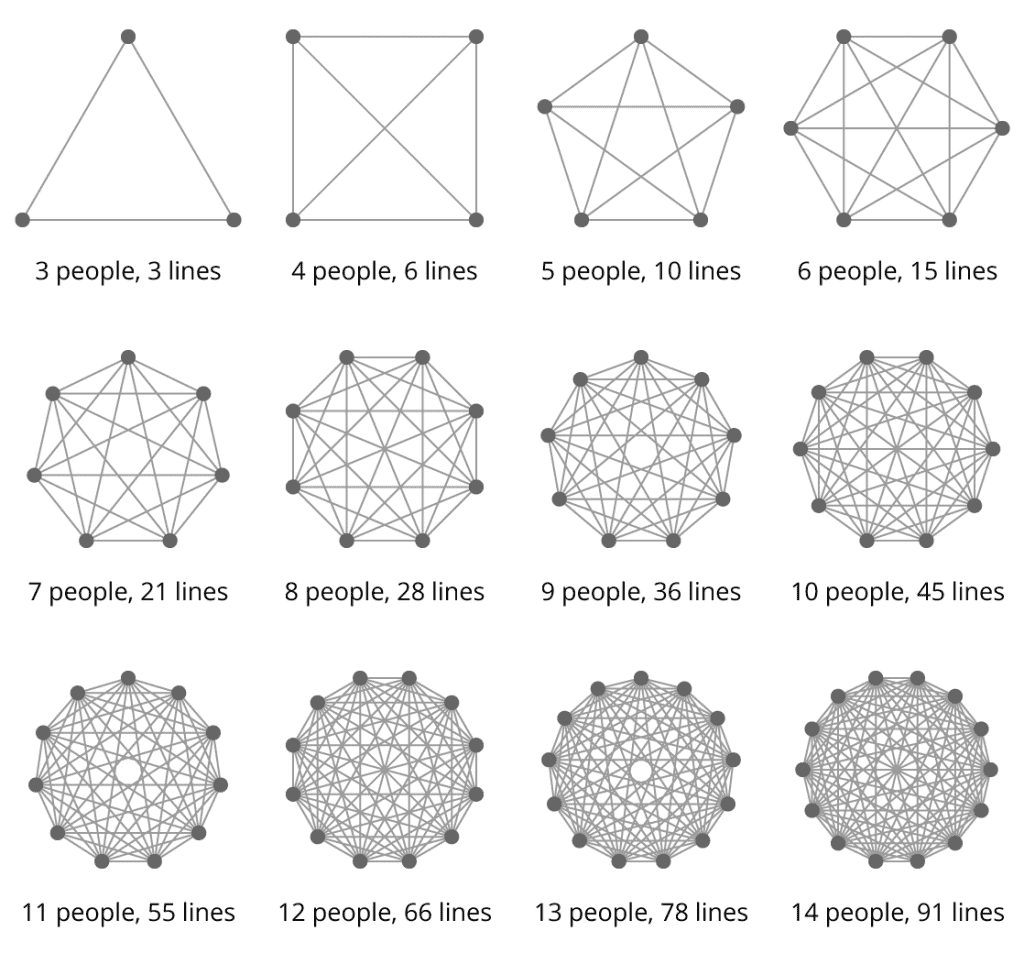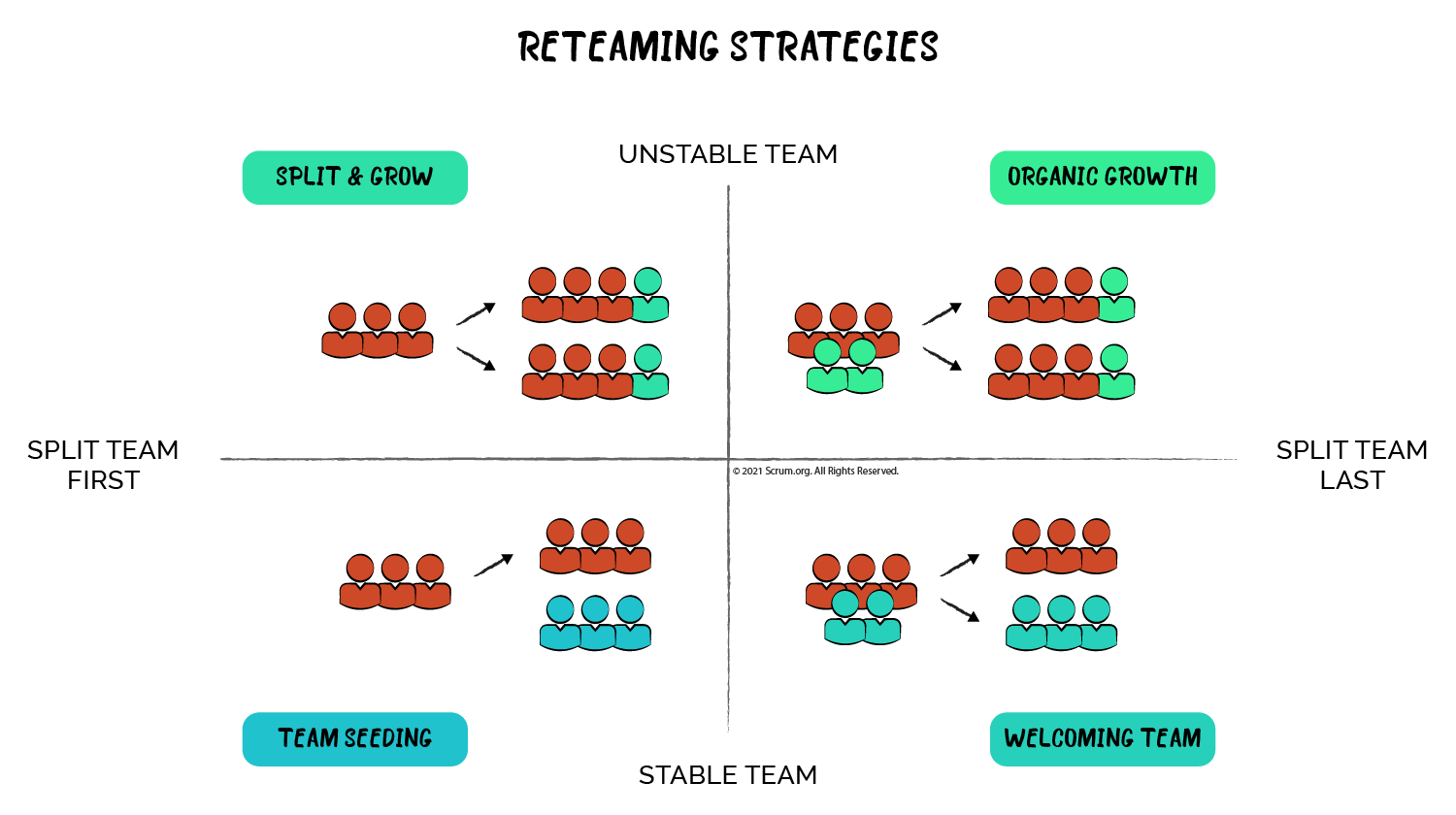The more successful a product becomes, the bigger it gets.
If more customers use the product, more features are requested, more support is needed, and new market opportunities open up. To meet growing demands, additional team members are being added.
Everyone who has been in this situation knows what happens:
- Meetings and coordination take longer.
- It becomes more difficult to involve everyone in the decision-making process.
- The work of the individual team members diverges as they no longer work towards a common goal.
- The team no longer has a holistic view of the product.
- It becomes increasingly difficult to keep track of who is actually on the team and who is not.
All of these are indicators that the team needs to be split into separate teams.
When we decide to split a team, the following questions inevitably arise: What is the optimal team size? At what size should a team be divided? What are the options for adding new team members or teams?
The optimal team size is around 7
According to Psychologist Miller, the optimal team size is 7 plus or minus 2 people.
According to his studies, a person can hold about 7 pieces of information in short memory simultaneously. Everyone can observe this effect firsthand in meetings. According to Glaser, meetings with more than 7 participants lose efficiency.
A study by Quality Software Management found that a team size of about 7 people, besides pure efficiency, has other benefits: It provides some protection against key people being taken away. Individual performance is not lost in the group. It is conducive to motivation and cohesion. Teams of this size do not require significant management effort. This is also consistent with my experience that smaller teams communicate better and are more productive.
If we continue to add team members, we eventually reach a point where productivity decreases and the time for coordination increases noticeably. Therefore, we are looking for the maximum team size that allows each team member to contribute and communicate with everyone without slowing down the work process.
The maximum team size is about 10
The British Anthropology Professor R.I.M. Dunbar states that the maximum reasonable team size is no more than 10 to 12 people. The Scrum Guide follows this recommendation and states that a Scrum team should typically be 10 or fewer in size.
The number 10 should not be taken as a strict limit here but as a recommendation based on the number of relationships among team members. These relationships can be simplified as communication lines. For a team with 10 members, there are 45 communication channels between the team members. Each member must maintain this to work together towards a common goal. What is interesting is not the number 45 but the almost exponential increase in relationships as more members are added. A team with 15 people already has to maintain twice as many relationships within the team. Therefore, with a team size of more than 10 people, we should begin to divide teams to continue to work effectively.

What are the ways to split a team?
4 ways to add team members and split teams
In general, we refer to adding team members and spitting teams as reteaming strategies.
Reteaming strategies emerge based on the following questions:
- Should the existing team be kept stable?
- Should the team be split before new people are added?
This consideration leads to the following 4 reteaming strategies:

Split & Grow: Split team, then add people to teams
If the size of a team is to be doubled, then it is helpful first to split the team into two teams and then add members. This approach allows you to add more teams quickly. The new teams also only need to reteam once to become high-performing again. In addition, much of the knowledge and experience of the original team is retained in the new team and does not need to be reacquired.
Organic Growth: Add people to the teams, then split the team
We talk about organic growth when new members are added to the team step by step, and the team is split when the maximum size is reached. This organic growth allows team members to learn from each other as long and easily as possible. It is easier to spread knowledge about the product and ways of working within a team than across team boundaries.
Team Seeding: Add new teams in parallel
According to a study by Rally Software, stable teams result in 60% more productivity, 40% more predictability, and 60% more adaptability. If these benefits should be maintained, it is beneficial to seed another team in parallel. This approach is also helpful when the existing culture should not be continued, or issues should be approached from a fresh perspective.
Welcome teams: Help new people learn the way of working first
If we add new team members to existing teams, they can easily get to know the culture and way of working. A team through which new members rotate is called a "welcome team". According to Heidi Helfand, teams that have a highly collaborative culture are best suited for welcome teams. After some time, the new team members form their own teams and adopt the welcome team's way of working. In addition to sharing knowledge and experience, this approach also has the advantage that the high-performing "welcome team" is not lost when the team is split.
Want to learn more?
Hopefully, this article was helpful for you. Reteaming is one of the many interesting topics that is covered in the Scaled Professional Scrum course. If you’d like to join the Scaled Professional Scrum course, check out my class schedule page for more information.
